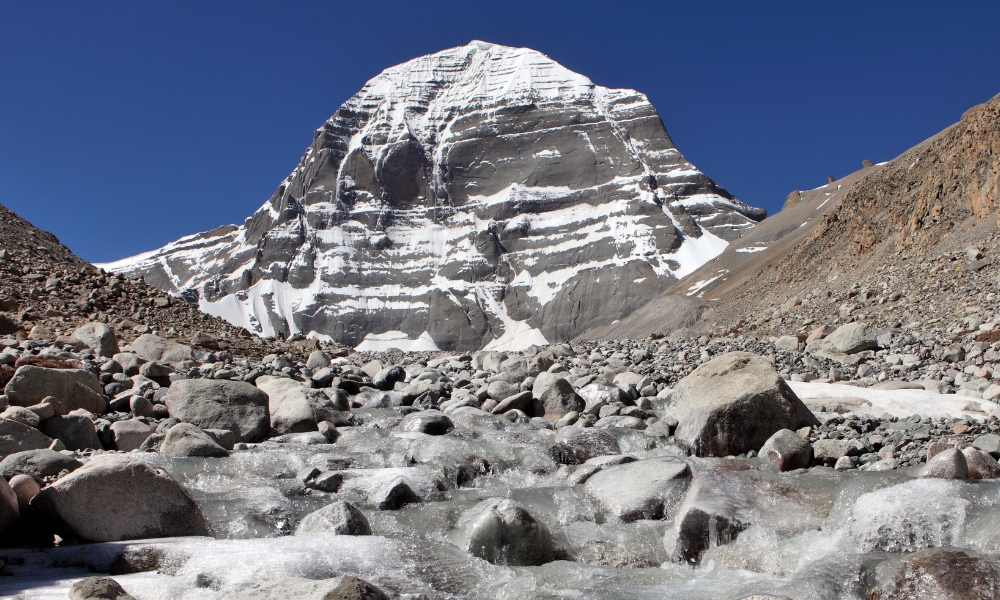Mount Kailash Accessible from Indian Territory Soon
 Mount Kailash, nestled majestically in the Himalayan range, has captivated the hearts and minds of pilgrims, adventurers, and spiritual seekers for centuries. Considered one of the holiest places on Earth by several religions, including Hinduism, Buddhism, Jainism, and Bon, this sacred mountain has remained elusive to many due to its location in Tibet, which posed significant travel restrictions. However, in a remarkable turn of events, plans are underway to open a new route that will allow visitors to embark on a spiritual journey to Mount Kailash from the Indian territory.
Mount Kailash, nestled majestically in the Himalayan range, has captivated the hearts and minds of pilgrims, adventurers, and spiritual seekers for centuries. Considered one of the holiest places on Earth by several religions, including Hinduism, Buddhism, Jainism, and Bon, this sacred mountain has remained elusive to many due to its location in Tibet, which posed significant travel restrictions. However, in a remarkable turn of events, plans are underway to open a new route that will allow visitors to embark on a spiritual journey to Mount Kailash from the Indian territory.
Mount Kailash, standing tall at 6,638 meters above sea level, is more than just a physical landmark; it is steeped in spiritual significance. For Hindus, the mountain is believed to be the abode of Lord Shiva, the deity of destruction and transformation, and his divine consort, Goddess Parvati. To Buddhists, Mount Kailash is Kang Rinpoche, considered the spiritual center of the world, and circumambulating it is a symbol of achieving enlightenment. Jainism reveres the mountain as Astapada, the place of liberation, and in the Bon religion, it is considered the axis mundi, the connection between the physical and spiritual realms.
For generations, devout pilgrims from India and beyond have longed to undertake the revered Kailash Mansarovar Yatra, a spiritual journey that involves circumambulating the sacred mountain and taking a dip in the pristine waters of Lake Mansarovar, which lies at the base of Mount Kailash. This arduous pilgrimage, which traditionally began in Tibet, demanded significant time, money, and diplomatic approvals, often limiting access to only a fortunate few.
New Access Route from Indian Territory
The announcement of a new access route to Mount Kailash from the Indian territory has been met with jubilation and excitement among spiritual seekers, pilgrims, and adventure enthusiasts. The proposed route is expected to originate from the Indian state of Uttarakhand, which shares its borders with Tibet. This development is likely to significantly ease the logistics and accessibility of the pilgrimage, making it more feasible for a larger number of devotees to undertake this sacred journey.
On the other hand, the local communities in Uttarakhand are likely to experience a boost in their economy, as increased pilgrim footfall will generate opportunities for hospitality, transportation, and other support services. However, it is essential that sustainable tourism practices are implemented to ensure the protection of the delicate Himalayan ecosystem and the preservation of the region’s unique cultural heritage.
Challenges and Considerations
While the prospect of a new access route is exciting, there are several challenges and considerations that need to be addressed. Environmental conservation should be at the forefront of any development plans, with measures in place to mitigate the impact of increased footfall on the mountain and its surroundings. Cooperation and coordination between India and China will be crucial to facilitate a smooth and secure pilgrimage experience.
Furthermore, ensuring the safety and well-being of the pilgrims during the journey, which involves trekking at high altitudes, will require adequate planning, preparation, and medical facilities along the route. Additionally, maintaining the sanctity and serenity of the pilgrimage experience amidst a potentially larger number of visitors should be a top priority.
The prospect of visiting Mount Kailash from the Indian territory marks a significant milestone for spiritual seekers, pilgrims, and adventurers alike. This new access route opens doors to a transformative journey, allowing devotees to partake in the profound Kailash Mansarovar Yatra and experience the divine aura of this sacred mountain. As we move closer to realizing this dream, it is vital to approach this development with mindfulness, sensitivity, and respect for the spiritual significance of the place and the preservation of its pristine environment. The opening of this new access route presents an opportunity for individuals from all walks of life to embark on an unforgettable spiritual expedition, forging a deeper connection with nature, culture, and the divine.



